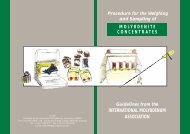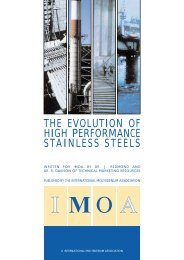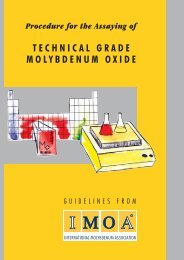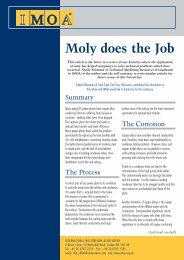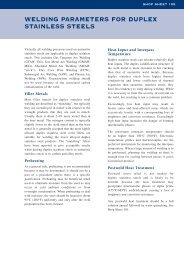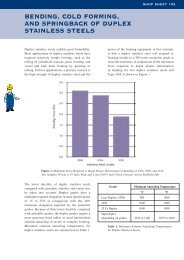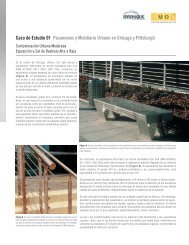Molybdenum - an extraordinary metal in high demand - IMOA
Molybdenum - an extraordinary metal in high demand - IMOA
Molybdenum - an extraordinary metal in high demand - IMOA
You also want an ePaper? Increase the reach of your titles
YUMPU automatically turns print PDFs into web optimized ePapers that Google loves.
®<br />
I M O A<br />
INTERNATIONAL MOLYBDENUM ASSOCIATION<br />
<strong>Molybdenum</strong> - <strong>an</strong> <strong>extraord<strong>in</strong>ary</strong> <strong>metal</strong> <strong>in</strong> <strong>high</strong> dem<strong>an</strong>d<br />
By H<strong>an</strong>s Imgrund <strong>an</strong>d Nicole K<strong>in</strong>sm<strong>an</strong>, International <strong>Molybdenum</strong> Association<br />
Ferromolybdenum (left); Roast<strong>in</strong>g molybdenite concentrate (right). Courtesy of Molymet, Chile<br />
A repr<strong>in</strong>t from the September 2007 issue of Sta<strong>in</strong>less Steel World<br />
International <strong>Molybdenum</strong> Association<br />
Rue Père Eudore Devroye 245, 1150 Brussels, Belgium<br />
Tel: +32 2 770 8878 · Fax: +32 2 770 8898<br />
e-mail: <strong>in</strong>fo@imoa.<strong>in</strong>fo · www.imoa.<strong>in</strong>fo
<strong>Molybdenum</strong> - <strong>an</strong> extraordi<br />
The US Air Force Memorial <strong>in</strong> Arl<strong>in</strong>gton, Virg<strong>in</strong>ia,<br />
USA, was designed by James Ingo Freed. It features<br />
three curved spires of welded, 19mm-thick,<br />
type 316 sta<strong>in</strong>less steel plate up to 82 metres <strong>in</strong><br />
height. Photo: Patrick McCafferty.<br />
20 S T A I N L E S S S T E E L W O R L D J U L Y / A U G U S T 2 0 0 7 www.sta<strong>in</strong>less-steel-world.net
Materials<br />
nary <strong>metal</strong> <strong>in</strong> <strong>high</strong> dem<strong>an</strong>d<br />
The recent nickel shortage has attracted a lot of attention. What is less known is that molybdenum<br />
too is <strong>in</strong> ever greater dem<strong>an</strong>d, with tighten<strong>in</strong>g supplies <strong>an</strong>d soar<strong>in</strong>g prices. A world-wide<br />
boom <strong>in</strong> <strong>in</strong>frastructure projects, especially those which have critical applications, has fuelled<br />
dem<strong>an</strong>d for this versatile <strong>metal</strong>. Sta<strong>in</strong>less Steel World asked Nicole K<strong>in</strong>sm<strong>an</strong> <strong>an</strong>d H<strong>an</strong>s Imgrund of<br />
the International <strong>Molybdenum</strong> Association to expla<strong>in</strong> the background <strong>an</strong>d <strong>in</strong>dicate what the future<br />
may hold. Their f<strong>in</strong>d<strong>in</strong>gs suggest that supplies will rema<strong>in</strong> tight <strong>in</strong> the short term, but that the<br />
long-term supply prospects are look<strong>in</strong>g good.<br />
MATERIALS<br />
By H<strong>an</strong>s Imgrund <strong>an</strong>d Nicole K<strong>in</strong>sm<strong>an</strong>, International <strong>Molybdenum</strong> Association<br />
Introductory<br />
In the last four years dem<strong>an</strong>d for<br />
molybdenum soared by 35 per cent.<br />
This surge comes ma<strong>in</strong>ly from a<br />
strong world-wide push to <strong>in</strong>vest <strong>in</strong><br />
<strong>in</strong>dustrial <strong>in</strong>frastructure: from a factory<br />
build<strong>in</strong>g boom <strong>in</strong> Ch<strong>in</strong>a to a<br />
rush to develop oilfields, m<strong>an</strong>y projects<br />
rely on the help of materials<br />
conta<strong>in</strong><strong>in</strong>g molybdenum.<br />
All this activity has trickled down to<br />
<strong>Molybdenum</strong> facts<br />
• About 25 per cent of all molybdenum<br />
produced is used to make<br />
moly-grade sta<strong>in</strong>less steel.<br />
• About 50 per cent is used for other<br />
iron-based <strong>metal</strong>s, such as construction<br />
steel, tool <strong>an</strong>d <strong>high</strong>-speed<br />
steel <strong>an</strong>d cast iron.<br />
• <strong>Molybdenum</strong> as <strong>an</strong> alloy<strong>in</strong>g element<br />
<strong>in</strong> steel is almost always used<br />
<strong>in</strong> comb<strong>in</strong>ation with other elements<br />
such as chromium, nickel, v<strong>an</strong>adium,<br />
tungsten or niobium.<br />
• Steel mills add molybdenum either<br />
as molybdenum oxide or ferromolybdenum.<br />
• The rema<strong>in</strong><strong>in</strong>g 25 per cent is purified<br />
<strong>an</strong>d used as moly <strong>metal</strong>, as <strong>an</strong><br />
alloy<strong>in</strong>g element <strong>in</strong> nickel <strong>an</strong>d other<br />
super alloys, as catalysts, lubric<strong>an</strong>ts,<br />
flame retard<strong>an</strong>ts, corrosion<br />
<strong>in</strong>hibitors <strong>an</strong>d pigments.<br />
• Super alloy producers use moly<br />
<strong>metal</strong> pellets as a <strong>high</strong>-purity alloy<strong>in</strong>g<br />
addition.<br />
<strong>an</strong> <strong>in</strong>crease <strong>in</strong> dem<strong>an</strong>d for the <strong>metal</strong><br />
<strong>an</strong>d the tr<strong>an</strong>sformation of a market<br />
that had been stagn<strong>an</strong>t for nearly 20<br />
years. <strong>Molybdenum</strong> has diverse appeal:<br />
it is used <strong>in</strong> pipel<strong>in</strong>es, to improve<br />
strength to tr<strong>an</strong>sport oil <strong>an</strong>d<br />
gas under <strong>high</strong> pressure; <strong>in</strong> process<strong>in</strong>g<br />
vessels <strong>in</strong> the chemical <strong>in</strong>dustry,<br />
to withst<strong>an</strong>d corrosion <strong>in</strong> <strong>an</strong> array<br />
of solutions; <strong>an</strong>d even <strong>in</strong> sculptures,<br />
such as the US Air Force Memorial,<br />
which is located just across the river<br />
from Wash<strong>in</strong>gton, DC, to keep their<br />
f<strong>in</strong>ish sh<strong>in</strong>y for a long time.<br />
The global <strong>in</strong>terest <strong>in</strong> go<strong>in</strong>g “green”<br />
has also had <strong>an</strong> impact: as more<br />
comp<strong>an</strong>ies reduce pl<strong>an</strong>t waste by recycl<strong>in</strong>g<br />
their waste streams with<strong>in</strong><br />
factory walls, moly-grade sta<strong>in</strong>less<br />
steels h<strong>an</strong>dle the <strong>high</strong>er corrosiveness<br />
that comes with <strong>high</strong>er concentration<br />
of aggressive subst<strong>an</strong>ces.<br />
Compounds of the element that allows<br />
steels to resist <strong>high</strong> temperatures<br />
<strong>an</strong>d sta<strong>in</strong>less steels to resist corrosive<br />
environments c<strong>an</strong> also work<br />
as <strong>an</strong> effective lubric<strong>an</strong>t, as a catalyst<br />
for the production of oil products or<br />
as a pigment to make or<strong>an</strong>ge pa<strong>in</strong>t.<br />
How molybdenum <strong>metal</strong> is<br />
used<br />
The most import<strong>an</strong>t properties of<br />
pure molybdenum <strong>metal</strong> <strong>an</strong>d molybdenum<br />
alloys are their <strong>high</strong> melt<strong>in</strong>g<br />
po<strong>in</strong>t (<strong>in</strong> the order of 2600°C), <strong>high</strong><br />
temperature resist<strong>an</strong>ce, <strong>high</strong> wear resist<strong>an</strong>ce<br />
<strong>an</strong>d good corrosion resist<strong>an</strong>ce.<br />
These products are often used<br />
<strong>in</strong> applications that require <strong>high</strong><br />
strength at <strong>high</strong> temperature, while<br />
their coefficient of exp<strong>an</strong>sion <strong>an</strong>d<br />
thermal conductivity also make<br />
them valuable to the electronics <strong>in</strong>dustry.<br />
Products made of molybdenum<br />
<strong>metal</strong> <strong>an</strong>d molybdenum base<br />
alloys <strong>in</strong>clude <strong>metal</strong> powder, wire,<br />
sheet, bar <strong>an</strong>d specialised powders.<br />
The price for molybdenum has spiked recently but was at low levels for much of the last 25 years.<br />
(Source: Metals Week)<br />
www.sta<strong>in</strong>less-steel-world.net S T A I N L E S S S T E E L W O R L D S E P T E M B E R 2 0 0 7 21
Materials<br />
Examples of the <strong>metal</strong>’s uses <strong>in</strong>clude<br />
parts of <strong>in</strong>dustrial furnaces,<br />
support wire for tungsten filaments<br />
<strong>in</strong> light bulbs, glass melt<strong>in</strong>g equipment,<br />
electronic equipment, <strong>an</strong>d<br />
<strong>metal</strong> <strong>an</strong>d plastic form<strong>in</strong>g equipment.<br />
One example of a <strong>metal</strong>form<strong>in</strong>g<br />
product is a pierc<strong>in</strong>g plug.<br />
It is made of TZM (a molybdenum<br />
alloy, dispersion-strengthened with<br />
tit<strong>an</strong>ium carbide <strong>an</strong>d zirconium oxide)<br />
<strong>an</strong>d used for the production of<br />
sta<strong>in</strong>less steel tub<strong>in</strong>g. Such pierc<strong>in</strong>g<br />
plugs are made of TZM because<br />
they must have <strong>high</strong> strength <strong>an</strong>d<br />
<strong>high</strong> wear resist<strong>an</strong>ce at the <strong>high</strong><br />
roll<strong>in</strong>g temperature of sta<strong>in</strong>less steel<br />
(see photo.)<br />
Mak<strong>in</strong>g a better sta<strong>in</strong>less<br />
steel<br />
<strong>Molybdenum</strong> is added to sta<strong>in</strong>less<br />
steels to <strong>in</strong>crease corrosion resist<strong>an</strong>ce.<br />
About 10 per cent of sta<strong>in</strong>less<br />
steel production conta<strong>in</strong>s molybdenum,<br />
of which the content averages<br />
about 2 per cent. Traditionally the<br />
most import<strong>an</strong>t moly-grade sta<strong>in</strong>less<br />
steel is the austenitic type 316 (18%<br />
Cr, 10% Ni <strong>an</strong>d 2 or 2.5% Mo),<br />
which represents about 7 per cent of<br />
global sta<strong>in</strong>less steel production. In<br />
recent years moly-grade ferritics<br />
have grown fast. These <strong>in</strong>clude<br />
types 444 (18% Cr, 2% Mo), 436<br />
(18% Cr, 1.25% Mo) <strong>an</strong>d 434 (17%<br />
Cr <strong>an</strong>d 1% Mo). The comb<strong>in</strong>ed tonnage<br />
of moly-grade ferritics has<br />
jumped from 47,000 metric tons <strong>in</strong><br />
2002 to 366,000 tons <strong>in</strong> 2005, accord<strong>in</strong>g<br />
to the International<br />
Sta<strong>in</strong>less Steel Forum. Their percentage<br />
of total sta<strong>in</strong>less production has<br />
grown from 0.3 per cent to 1.7 per<br />
cent <strong>in</strong> just three years. Duplex<br />
sta<strong>in</strong>less steels have also been grow<strong>in</strong>g<br />
strongly to <strong>an</strong> estimated<br />
200,000 metric tons <strong>in</strong> 2006.<br />
TZM pierc<strong>in</strong>g plug for the production (roll<strong>in</strong>g) of<br />
sta<strong>in</strong>less steel tubes (courtesy of Pl<strong>an</strong>see).<br />
This sculpture right next to the oce<strong>an</strong> shows corrosion sta<strong>in</strong><strong>in</strong>g on type 304 sta<strong>in</strong>less steel due to<br />
<strong>in</strong>correct grade selection <strong>in</strong> a dem<strong>an</strong>d<strong>in</strong>g environment.<br />
Industrial sectors<br />
The most import<strong>an</strong>t uses of molygrade<br />
sta<strong>in</strong>less steel are <strong>in</strong>dustrial.<br />
The chemical <strong>an</strong>d petrochemical, oil<br />
<strong>an</strong>d gas, paper, power, water, food<br />
<strong>an</strong>d pharmaceutical <strong>in</strong>dustries use<br />
process<strong>in</strong>g equipment made of molygrade<br />
austenitic <strong>an</strong>d duplex sta<strong>in</strong>less<br />
steels.<br />
Moly-grade sta<strong>in</strong>less steel is also used<br />
<strong>in</strong> architectural applications. The correct<br />
selection of sta<strong>in</strong>less steel <strong>in</strong><br />
these applications is essential to avoid<br />
unpleas<strong>an</strong>t surprises, for <strong>in</strong>st<strong>an</strong>ce<br />
where a moly-free grade was used<br />
next to the oce<strong>an</strong> (see photo).<br />
Because the sta<strong>in</strong>less steel selected<br />
here is not corrosion-resist<strong>an</strong>t enough<br />
for this difficult environment, this<br />
sculpture has to be cle<strong>an</strong>ed from superficial<br />
corrosion sta<strong>in</strong><strong>in</strong>g every year.<br />
The US Air Force Memorial, us<strong>in</strong>g a<br />
moly-grade type 316 sta<strong>in</strong>less steel<br />
(which conta<strong>in</strong>s 2 per cent molybdenum)<br />
will most likely not have this<br />
problem (see photo).<br />
Mak<strong>in</strong>g a stronger alloy steel<br />
<strong>Molybdenum</strong> enh<strong>an</strong>ces hardenability,<br />
strength <strong>an</strong>d toughness, <strong>an</strong>d elevates<br />
the temperature resist<strong>an</strong>ce of<br />
constructional steels. It is often used<br />
<strong>in</strong> comb<strong>in</strong>ation with chromium<br />
<strong>an</strong>d/or nickel <strong>an</strong>d other alloy<strong>in</strong>g elements,<br />
with the molybdenum content<br />
typically r<strong>an</strong>g<strong>in</strong>g from 0.2 to<br />
1.2 per cent. Moly-grade steel categories<br />
<strong>in</strong>clude heat-treatable eng<strong>in</strong>eer<strong>in</strong>g<br />
steels, case-hardened steels,<br />
<strong>high</strong>-temperature steels, oil country<br />
tubular goods <strong>an</strong>d HSLA (High<br />
Strength, Low Alloy) steels. These<br />
grades are used <strong>in</strong> all k<strong>in</strong>ds of eng<strong>in</strong>eered<br />
products for automotive,<br />
shipbuild<strong>in</strong>g, aircraft <strong>an</strong>d aerospace<br />
<strong>in</strong>dustries; drill<strong>in</strong>g, m<strong>in</strong><strong>in</strong>g <strong>an</strong>d pro-<br />
www.sta<strong>in</strong>less-steel-world.net S T A I N L E S S S T E E L W O R L D S E P T E M B E R 2 0 0 7 23
Materials<br />
These mill cutters are made of <strong>high</strong>-speed steel with 5 per cent Mo (courtesy of Boehler Edelstahl).<br />
cess<strong>in</strong>g <strong>in</strong>dustries; <strong>an</strong>d energy generation<br />
<strong>in</strong>dustries. Products <strong>in</strong>clude<br />
vessels, t<strong>an</strong>ks <strong>an</strong>d heat exch<strong>an</strong>gers,<br />
gears <strong>an</strong>d shafts, pip<strong>in</strong>g <strong>an</strong>d m<strong>an</strong>y<br />
more.<br />
Mak<strong>in</strong>g a longer-last<strong>in</strong>g tool<br />
steel<br />
<strong>Molybdenum</strong> contributes to secondary<br />
harden<strong>in</strong>g (<strong>in</strong> comb<strong>in</strong>ation with<br />
v<strong>an</strong>adium) <strong>in</strong> tool steels. It also separates<br />
the pearlite <strong>an</strong>d ba<strong>in</strong>ite reactions,<br />
<strong>an</strong>d therefore allows step<br />
quench<strong>in</strong>g. Products made of tool<br />
steels <strong>in</strong>clude h<strong>an</strong>d tools, knives<br />
<strong>an</strong>d saws, forg<strong>in</strong>g dies, pressure cast<strong>in</strong>g<br />
moulds <strong>an</strong>d mold<strong>in</strong>g plates. The<br />
typical molybdenum content <strong>in</strong> tool<br />
steels is around 0.8 per cent.<br />
<strong>Molybdenum</strong> contributes to secondary<br />
harden<strong>in</strong>g <strong>an</strong>d is <strong>an</strong> import<strong>an</strong>t<br />
constituent of the primary M6C carbide,<br />
which makes <strong>high</strong>-speed steels<br />
more wear-resist<strong>an</strong>t. Pr<strong>in</strong>cipal uses<br />
are for cutt<strong>in</strong>g tools <strong>an</strong>d saws for<br />
steel, cast <strong>an</strong>d non-ferrous materials,<br />
twist drills, mill<strong>in</strong>g cutters (see photo)<br />
<strong>an</strong>d push<strong>in</strong>g tools. The average<br />
molybdenum content <strong>in</strong> <strong>high</strong>-speed<br />
steels is around 5 per cent.<br />
<strong>Molybdenum</strong> m<strong>in</strong><strong>in</strong>g<br />
The ma<strong>in</strong> regions of molybdenum<br />
m<strong>in</strong><strong>in</strong>g <strong>in</strong>clude South America,<br />
North America <strong>an</strong>d Ch<strong>in</strong>a. These regions<br />
accounted for 93 per cent of<br />
global production <strong>in</strong> 2006, which<br />
was estimated to be 422 million<br />
pounds (192,000 metric tons).<br />
Roughly 60 per cent of molybdenum<br />
is produced as a by-product of<br />
<strong>an</strong>other m<strong>in</strong><strong>in</strong>g operation, most<br />
commonly copper production. The<br />
ore from copper m<strong>in</strong>es which also<br />
produce molybdenum usually conta<strong>in</strong>s<br />
between 0.5 <strong>an</strong>d 1.5 per cent<br />
copper (5 to 15 kg per metric ton of<br />
ore) <strong>an</strong>d between 0.01 <strong>an</strong>d 0.05 per<br />
cent molybdenum (0.1 to 0.5 kg/t).<br />
Major operations m<strong>in</strong>e more th<strong>an</strong><br />
50 million tons of ore per year, produc<strong>in</strong>g<br />
over 200,000 tons of copper<br />
<strong>an</strong>d between 5,000 <strong>an</strong>d 15,000 tons<br />
of moly. For every kilo of copper,<br />
between 20 <strong>an</strong>d 40 grams of moly is<br />
extracted.<br />
For these producers, it is a relatively<br />
<strong>in</strong>expensive step to extract molybdenum<br />
from the ore that is already<br />
ground up to take out copper. The<br />
revenues from molybdenum are<br />
usually less th<strong>an</strong> 10 per cent of total<br />
sales. Therefore, the molybdenum<br />
output does not necessarily<br />
follow the dem<strong>an</strong>d for molybdenum<br />
but the dem<strong>an</strong>d for copper.<br />
The moly output automatically <strong>in</strong>creases<br />
when the m<strong>in</strong>e <strong>in</strong>creases its<br />
copper production <strong>an</strong>d it falls when<br />
the m<strong>in</strong>e decreases its copper production<br />
because dem<strong>an</strong>d for copper<br />
falls.<br />
M<strong>in</strong><strong>in</strong>g for moly only (primary production)<br />
is much more expensive. A<br />
primary m<strong>in</strong>e <strong>in</strong> the West, with <strong>an</strong><br />
<strong>an</strong>nual production capacity <strong>in</strong> the<br />
order of 10,000 tons of molybdenum<br />
(22 million lbs), takes <strong>an</strong> <strong>in</strong>vestment<br />
of several hundred million<br />
US dollars to open. Of the 40<br />
per cent molybdenum from primary<br />
m<strong>in</strong>es, 25 per cent is produced<br />
<strong>in</strong> Ch<strong>in</strong>a <strong>an</strong>d the CIS <strong>an</strong>d 15<br />
per cent <strong>in</strong> the West.<br />
Ore grades <strong>in</strong> primary m<strong>in</strong>es conta<strong>in</strong><br />
between 0.12 <strong>an</strong>d 0.20 per cent<br />
moly. Thus, the production of<br />
10,000 tons of Mo requires m<strong>in</strong><strong>in</strong>g<br />
<strong>an</strong>d mill<strong>in</strong>g <strong>in</strong> excess of 5 million<br />
tons of ore per year. The cost of this<br />
has to be borne by the revenue<br />
www.sta<strong>in</strong>less-steel-world.net S T A I N L E S S S T E E L W O R L D S E P T E M B E R 2 0 0 7 25
Materials<br />
from molybdenum alone. Therefore<br />
the production of primary molybdenum<br />
is signific<strong>an</strong>tly more costly<br />
th<strong>an</strong> the production of by-product<br />
molybdenum. The primary m<strong>in</strong>es<br />
are sw<strong>in</strong>g producers, i.e. they <strong>in</strong>crease<br />
their production when the<br />
market has <strong>high</strong>er dem<strong>an</strong>d for<br />
molybdenum <strong>an</strong>d decrease their<br />
production when the dem<strong>an</strong>d is<br />
down.<br />
The ch<strong>an</strong>g<strong>in</strong>g structure of<br />
the <strong>in</strong>dustry<br />
The bal<strong>an</strong>ce of molybdenum m<strong>in</strong><strong>in</strong>g<br />
has shifted over the years from<br />
ma<strong>in</strong>ly primary production to<br />
ma<strong>in</strong>ly by-product production. As<br />
copper comp<strong>an</strong>ies have <strong>in</strong>creased<br />
<strong>an</strong>d optimized the recovery of<br />
molybdenum, the amount of byproduct<br />
molybdenum produced has<br />
<strong>in</strong>creased signific<strong>an</strong>tly <strong>in</strong> the last 15<br />
years. Dur<strong>in</strong>g that same time, production<br />
<strong>in</strong> Ch<strong>in</strong>a <strong>an</strong>d the availability<br />
of Ch<strong>in</strong>ese molybdenum for export<br />
to the rest of the world have<br />
also <strong>in</strong>creased.<br />
Because of these structural ch<strong>an</strong>ges,<br />
the primary m<strong>in</strong>es <strong>in</strong> North<br />
America that have traditionally produced<br />
the bulk of molybdenum<br />
have decreased their production<br />
<strong>an</strong>d have become sw<strong>in</strong>g producers:<br />
these m<strong>in</strong>es are only able to <strong>in</strong>crease<br />
their production, or come<br />
back on-stream, when the market<br />
dem<strong>an</strong>d requires their more costly<br />
molybdenum. The by-product<br />
m<strong>in</strong>es, on the contrary, produce<br />
their lower-cost molybdenum along<br />
with copper to fill the dem<strong>an</strong>d for<br />
copper <strong>an</strong>d do not adjust much to<br />
the market conditions for molybdenum.<br />
Market conditions became difficult<br />
<strong>in</strong> 2001 <strong>an</strong>d 2002, when the molybdenum<br />
price dropped even further<br />
after be<strong>in</strong>g already low for most of<br />
the previous 20 years. The production<br />
of the primary m<strong>in</strong>es <strong>in</strong> North<br />
America was reduced to less th<strong>an</strong> 45<br />
million pounds per year, or less<br />
th<strong>an</strong> 15 per cent of global production.<br />
With this low production level,<br />
the sw<strong>in</strong>g producers, the primary<br />
North Americ<strong>an</strong> m<strong>in</strong>es, were no<br />
longer able to adjust their production<br />
sufficiently to absorb ch<strong>an</strong>ges,<br />
particularly strong <strong>in</strong>creases <strong>in</strong> dem<strong>an</strong>d.<br />
Production of Western primary m<strong>in</strong>es has decreased when prices <strong>an</strong>d dem<strong>an</strong>d were low for<br />
several years. Production from these m<strong>in</strong>es was only about 40 million lb <strong>in</strong> 2001 <strong>an</strong>d 2002.<br />
(Source: <strong>IMOA</strong>, Metals Week).<br />
Global molybdenum dem<strong>an</strong>d has <strong>in</strong>creased strongly <strong>in</strong> the last four years after be<strong>in</strong>g stagn<strong>an</strong>t for<br />
several years. (Source: <strong>IMOA</strong>, Metals Week).<br />
<strong>Molybdenum</strong> m<strong>in</strong>e production <strong>in</strong> Ch<strong>in</strong>a has dropped <strong>in</strong> 2005 as m<strong>in</strong>es were closed due to safety<br />
concerns (Source: <strong>IMOA</strong>)<br />
26 S T A I N L E S S S T E E L W O R L D S E P T E M B E R 2 0 0 7 www.sta<strong>in</strong>less-steel-world.net
Materials<br />
Comp<strong>an</strong>y M<strong>in</strong>e Location Type<br />
Mont<strong>an</strong>a/<br />
Gruppo Mexico<br />
Estimated <strong>an</strong>nual<br />
capacity<br />
(million lb Mo)<br />
Status<br />
Butte USA Cu by-product 8 Reopened 2004<br />
Quadra M<strong>in</strong><strong>in</strong>g Ltd. Rob<strong>in</strong>son USA Cu by-product 1 Started 2006<br />
Taseko M<strong>in</strong>es Gibraltar C<strong>an</strong>ada Cu by-product 1 Reopened 2005<br />
Anglo Americ<strong>an</strong>/<br />
Falconbridge<br />
Amerigo (M<strong>in</strong>era<br />
Valle Central)<br />
Golden Phoenix<br />
M<strong>in</strong>erals<br />
Collahausi Chile Cu by-product 7 Started 2005<br />
- Chile Cu by-product 1 Started 2005<br />
Ashdown USA Primary 0.5 Started 2006<br />
Roxmark M<strong>in</strong>es Nortoba - Tyson C<strong>an</strong>ada Primary 1 Started 2006<br />
Table 1: Mloybdenum m<strong>in</strong>es recently started or reopened (source: Adams Metals)<br />
<strong>Molybdenum</strong> dem<strong>an</strong>d has<br />
<strong>in</strong>creased signific<strong>an</strong>tly<br />
As <strong>in</strong>dicated already, the uses for<br />
molybdenum-conta<strong>in</strong><strong>in</strong>g products<br />
are mostly <strong>in</strong>dustrial <strong>an</strong>d <strong>in</strong>clude energy<br />
generation, oil <strong>an</strong>d gas, chemical<br />
process<strong>in</strong>g, tr<strong>an</strong>sportation, m<strong>in</strong><strong>in</strong>g,<br />
mech<strong>an</strong>ical eng<strong>in</strong>eer<strong>in</strong>g, build<strong>in</strong>g<br />
<strong>an</strong>d construction <strong>an</strong>d fabrication.<br />
[Dem<strong>an</strong>d for molybdenum]<br />
M<strong>an</strong>y of these sectors have seen <strong>an</strong><br />
up cycle <strong>in</strong> <strong>in</strong>vestment <strong>in</strong> the last<br />
few years. High oil prices have boosted<br />
exploration <strong>an</strong>d brought new production<br />
facilities onl<strong>in</strong>e. The new<br />
fields often are more difficult to<br />
reach <strong>an</strong>d more difficult to tap.<br />
Higher temperatures, pressures <strong>an</strong>d<br />
concentrations result <strong>in</strong> a need for<br />
better (often molybdenum-alloyed)<br />
materials. Five to ten years ago, for<br />
example, ref<strong>in</strong>eries did not need to<br />
use much sta<strong>in</strong>less steel <strong>in</strong> their process<strong>in</strong>g.<br />
Today, the raw oil to be<br />
processed is becom<strong>in</strong>g <strong>in</strong>creas<strong>in</strong>gly<br />
aggressive, so sta<strong>in</strong>less steel equipment<br />
is becom<strong>in</strong>g more common.<br />
The general trend <strong>in</strong> the chemical<br />
<strong>an</strong>d petrochemical <strong>in</strong>dustries of <strong>in</strong>creas<strong>in</strong>g<br />
process temperatures <strong>an</strong>d<br />
pressures to <strong>in</strong>crease pl<strong>an</strong>t efficiency<br />
also favours the use of moly-grade<br />
materials. Similarly, environmentally<br />
friendly process<strong>in</strong>g, where effluents<br />
are recycled <strong>in</strong> the pl<strong>an</strong>t <strong>in</strong>stead<br />
of be<strong>in</strong>g released to the environment,<br />
<strong>in</strong>creases the need for<br />
moly-conta<strong>in</strong><strong>in</strong>g materials that c<strong>an</strong><br />
withst<strong>an</strong>d the <strong>high</strong>er concentrations<br />
of aggressive compounds.<br />
F<strong>in</strong>ally, the rapid exp<strong>an</strong>sion of the<br />
Ch<strong>in</strong>ese economy, creat<strong>in</strong>g a need<br />
for more <strong>in</strong>dustrial process<strong>in</strong>g<br />
pl<strong>an</strong>ts <strong>an</strong>d for <strong>in</strong>vestment <strong>in</strong> new<br />
<strong>in</strong>frastructure, has multiplied the<br />
use of moly-grade materials <strong>in</strong> that<br />
part of the world <strong>in</strong> just a few years.<br />
Therefore, molybdenum dem<strong>an</strong>d<br />
had a compounded <strong>an</strong>nual growth<br />
rate of 8 per cent between 2002 <strong>an</strong>d<br />
2006. Such market conditions have<br />
not been seen for decades. In fact,<br />
between 1990 <strong>an</strong>d 2006 the growth<br />
rate was only 3.3 per cent per year.<br />
To express this <strong>in</strong> weight: <strong>in</strong> the 12<br />
years between 1990 <strong>an</strong>d 2002 the<br />
dem<strong>an</strong>d for molybdenum <strong>in</strong>creased<br />
by 58 million pounds. In the last<br />
four years, between 2002 <strong>an</strong>d 2006,<br />
the dem<strong>an</strong>d <strong>in</strong>creased by 112 mil-<br />
Comp<strong>an</strong>y M<strong>in</strong>e Location Type<br />
Pl<strong>an</strong>ned <strong>an</strong>nual<br />
capacity<br />
(million lb Mo)<br />
Status<br />
Probable<br />
start-up<br />
Freeport / PD Cerro Verde Peru Cu by-product 8 Commission<strong>in</strong>g Q2 2007<br />
Roca M<strong>in</strong>es Max Moly C<strong>an</strong>ada Primary 5 Under Construction Q3 2007<br />
Alumbrera<br />
Bajo de la<br />
Alumbrera<br />
Argent<strong>in</strong>a Cu by-product 5 Under Construction Q4 2007<br />
BHP P<strong>in</strong>to Valley USA Cu by-product 3 Under Construction Q4 2007<br />
Mercator M<strong>in</strong>eral Park USA Cu by-product 10 Under Construction Q2 2008<br />
Ad<strong>an</strong>ac Ruby Creek C<strong>an</strong>ada Primary 10<br />
Moly M<strong>in</strong>es<br />
Ltd.<br />
Sp<strong>in</strong>fex Ridge Australia Cu by-product 20<br />
Grupo Mexico C<strong>an</strong>enea Mexico Cu by-product 10<br />
Freeport / PD Climax USA Primary 20 to 30<br />
Idaho General Mount Hope USA Primary 30<br />
Thompson Cree Davison C<strong>an</strong>ada Primary 8<br />
Table 2. Likely molybdenum m<strong>in</strong>e projects (source: Adams Metals)<br />
Feasability complete;<br />
contract<strong>in</strong>g<br />
Complet<strong>in</strong>g<br />
feasability<br />
Complet<strong>in</strong>g<br />
feasability<br />
Restarted -<br />
conditionally approved<br />
Complet<strong>in</strong>g<br />
feasability<br />
Start<strong>in</strong>g feasability<br />
study<br />
Q2 2009<br />
Q3 2009<br />
Q3 2009<br />
2010<br />
2011<br />
2012<br />
28 S T A I N L E S S S T E E L W O R L D S E P T E M B E R 2 0 0 7 www.sta<strong>in</strong>less-steel-world.net
Materials<br />
Ch<strong>in</strong>a 43%<br />
lion pounds, from 310 million<br />
pounds to 422 million pounds. This<br />
is over 35 per cent of the total dem<strong>an</strong>d<br />
<strong>in</strong> 2002 <strong>an</strong>d 2.5 times as<br />
much as the primary m<strong>in</strong>e production<br />
<strong>in</strong> the same year. This situation<br />
has created a major stra<strong>in</strong> on the<br />
supply of molybdenum.<br />
<strong>Molybdenum</strong> supply<br />
M<strong>in</strong><strong>in</strong>g operations take m<strong>an</strong>y years<br />
to develop <strong>an</strong>d start. Feasibility<br />
studies, environmental impact studies,<br />
negotiation with local residents<br />
<strong>an</strong>d f<strong>in</strong><strong>an</strong>c<strong>in</strong>g are just part of the<br />
process needed to start a new m<strong>in</strong>e<br />
or restart a mothballed one. Because<br />
of this, <strong>metal</strong> production c<strong>an</strong>not be<br />
quickly <strong>in</strong>creased when dem<strong>an</strong>d <strong>in</strong>creases<br />
sharply.<br />
Of course, there is some flexibility<br />
to <strong>in</strong>crease production <strong>in</strong> exist<strong>in</strong>g<br />
m<strong>in</strong>es, but that flexibility is limited<br />
to a few percentage po<strong>in</strong>ts. The<br />
sharp rise <strong>in</strong> dem<strong>an</strong>d after 2002<br />
overwhelmed the sw<strong>in</strong>g producers,<br />
who had seen their bus<strong>in</strong>ess shr<strong>in</strong>k<strong>in</strong>g<br />
cont<strong>in</strong>uously dur<strong>in</strong>g the five<br />
preced<strong>in</strong>g years. At the same time,<br />
molybdenum production <strong>in</strong> Ch<strong>in</strong>a<br />
was not able to compensate for this<br />
limitation. Its production actually<br />
decreased <strong>in</strong> 2005, ma<strong>in</strong>ly because<br />
the Ch<strong>in</strong>ese government had to<br />
close some m<strong>in</strong>es due to safety concerns.<br />
The problem was further compounded<br />
by limited roast<strong>in</strong>g capacities.<br />
Roast<strong>in</strong>g is a necessary step to ref<strong>in</strong>e<br />
molybdenum. Accord<strong>in</strong>g to estimates<br />
by Climax <strong>Molybdenum</strong> (presented<br />
at the 2005 Ry<strong>an</strong>’s Notes<br />
CIS & Mongolia 8%<br />
South America 16%<br />
North America 33%<br />
Global molybdenum reserves total 19 million tons <strong>an</strong>d are ma<strong>in</strong>ly situated <strong>in</strong> Ch<strong>in</strong>a <strong>an</strong>d North<br />
America (source: US Geological Survey 2006).<br />
Conference), the Western roasters<br />
were runn<strong>in</strong>g at a capacity utilization<br />
rate of 77 per cent <strong>in</strong> 2003, which<br />
moved up to 94 per cent <strong>in</strong> 2004 <strong>an</strong>d<br />
reached 100 per cent <strong>in</strong> 2005.<br />
This comb<strong>in</strong>ation of circumst<strong>an</strong>ces<br />
led to the current - <strong>an</strong>d unexpected<br />
- tight supply of molybdenum.<br />
About the authors<br />
Dr. H<strong>an</strong>s Imgrund<br />
works as a part-time<br />
consult<strong>an</strong>t to <strong>IMOA</strong>.<br />
A Germ<strong>an</strong> national,<br />
he studied<br />
<strong>metal</strong>lurgy at the<br />
Clausthal Bergakademie <strong>an</strong>d the<br />
Technical University <strong>in</strong> Berl<strong>in</strong>. He<br />
started his career <strong>in</strong> the moly<br />
bus<strong>in</strong>ess <strong>in</strong> 1973 as a development<br />
eng<strong>in</strong>eer of Climax <strong>Molybdenum</strong><br />
Comp<strong>an</strong>y.<br />
He worked as Vice President Sales<br />
<strong>an</strong>d Market<strong>in</strong>g for Climax <strong>an</strong>d for<br />
Cyprus M<strong>in</strong>es Corporation from 1981<br />
until his retirement from Climax <strong>in</strong><br />
2003.<br />
He was actively <strong>in</strong>volved <strong>in</strong> the<br />
foundation of <strong>IMOA</strong> <strong>an</strong>d has served<br />
on <strong>IMOA</strong>’s Executive Committee s<strong>in</strong>ce<br />
its <strong>in</strong>ception <strong>in</strong> 1989.<br />
High dem<strong>an</strong>d leads to m<strong>in</strong>e<br />
<strong>an</strong>d roast<strong>in</strong>g exp<strong>an</strong>sions<br />
The tight supply situation <strong>an</strong>d the<br />
cont<strong>in</strong>ued <strong>high</strong> prices of molybdenum<br />
over the last four years have<br />
prompted m<strong>an</strong>y m<strong>in</strong><strong>in</strong>g comp<strong>an</strong>ies<br />
to develop new molybdenum m<strong>in</strong><strong>in</strong>g<br />
<strong>an</strong>d roast<strong>in</strong>g facilities. Projects<br />
have become possible that would<br />
not have been profitable at the low<br />
molybdenum prices previously seen.<br />
New operations that opened <strong>in</strong> the<br />
Americas s<strong>in</strong>ce 2003 have added <strong>an</strong><br />
estimated <strong>an</strong>nual capacity of almost<br />
20 million pounds. Production <strong>in</strong><br />
Ch<strong>in</strong>a also <strong>in</strong>creased by some 20<br />
million pounds <strong>in</strong> 2006.<br />
Additionally, m<strong>an</strong>y new projects are<br />
under consideration <strong>an</strong>d <strong>in</strong> various<br />
pl<strong>an</strong>n<strong>in</strong>g <strong>an</strong>d construction stages. A<br />
shortlist c<strong>an</strong> be found <strong>in</strong> table 2,<br />
provided by Terry Adams of Adams<br />
Metals Ltd. The lead times for some<br />
of these projects are very long.<br />
Accord<strong>in</strong>g to Mr Adams there are<br />
around 500 other molybdenum<br />
projects <strong>in</strong> discussion with vary<strong>in</strong>g<br />
probabilities of completion.<br />
Roast<strong>in</strong>g capacity should also be<br />
grow<strong>in</strong>g soon as capacities <strong>in</strong> the<br />
Western world are projected to <strong>in</strong>crease<br />
from today’s 340 million<br />
pounds to 410 million pounds by<br />
2010.<br />
For the long term, known reserves<br />
for molybdenum amount to 19 million<br />
metric tons, accord<strong>in</strong>g to the<br />
US Geological Survey of 2006. This<br />
would be sufficient for 100 years at<br />
present dem<strong>an</strong>d levels, provid<strong>in</strong>g us<br />
with a corrosion-free future for<br />
m<strong>an</strong>y years to come.<br />
Dr. Nicole K<strong>in</strong>sm<strong>an</strong><br />
is the Technical<br />
Director of the<br />
International<br />
<strong>Molybdenum</strong><br />
Association (<strong>IMOA</strong>).<br />
A Swiss citizen, she studied<br />
mech<strong>an</strong>ical eng<strong>in</strong>eer<strong>in</strong>g <strong>an</strong>d<br />
<strong>metal</strong>lurgy at the Swiss Federal<br />
Institute of Technology <strong>in</strong> Zurich (ETH)<br />
<strong>an</strong>d bus<strong>in</strong>ess adm<strong>in</strong>istration at<br />
Carnegie Mellon University <strong>in</strong><br />
Pittsburgh, USA. In 1995 she started<br />
her career as a market development<br />
m<strong>an</strong>ager at TMR <strong>in</strong> Pittsburgh, a<br />
consult<strong>in</strong>g comp<strong>an</strong>y focus<strong>in</strong>g on<br />
technical consult<strong>in</strong>g <strong>in</strong> sta<strong>in</strong>less steel.<br />
S<strong>in</strong>ce 2002 she is Technical Director<br />
of <strong>IMOA</strong>, <strong>in</strong> charge of the market<br />
development programme of the<br />
association.<br />
www.sta<strong>in</strong>less-steel-world.net S T A I N L E S S S T E E L W O R L D S E P T E M B E R 2 0 0 7 31



